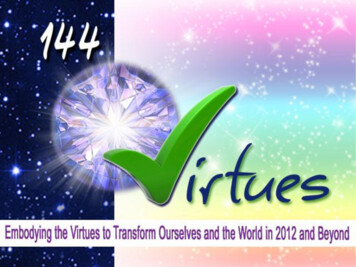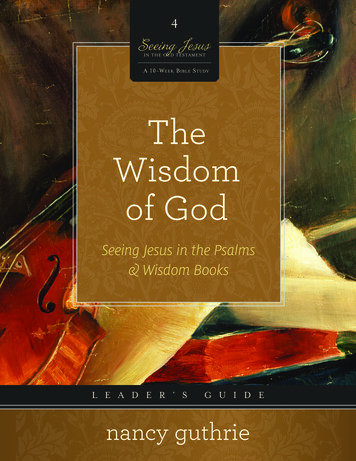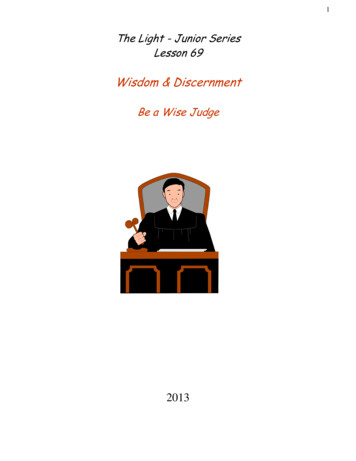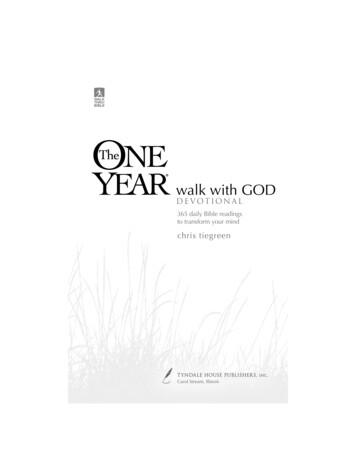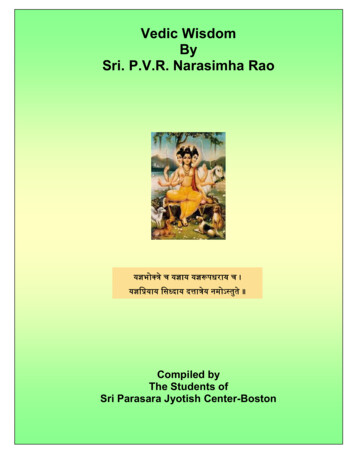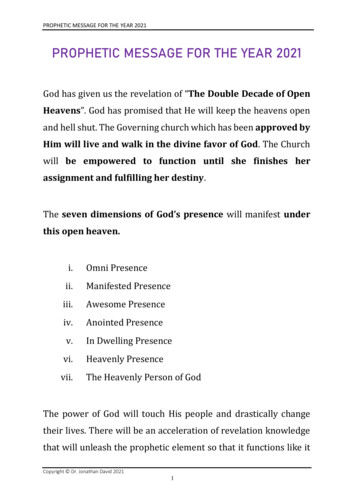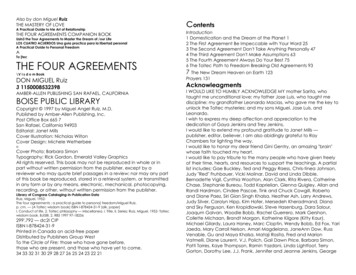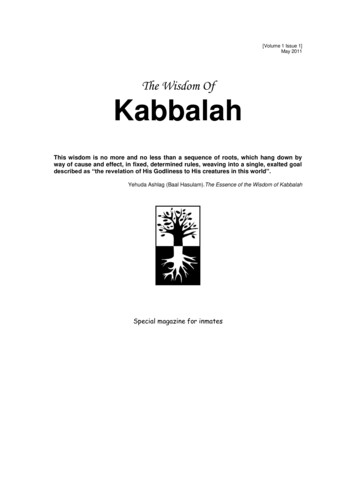
Transcription
[Volume 1 Issue 1]May 2011The Wisdom OfKabbalahThis wisdom is no more and no less than a sequence of roots, which hang down byway of cause and effect, in fixed, determined rules, weaving into a single, exalted goaldescribed as “the revelation of His Godliness to His creatures in this world”.Yehuda Ashlag (Baal Hasulam).The Essence of the Wisdom of KabbalahSpecial magazine for inmates
Table of ContentsEDITORIAL . 3ABOUT BNEI BARUCH . 4WHY SPIRITUALITY? . 6Why Now? . 6What Is Kabbalah? . 6Why Kabbalah? . 7The Truth About Reality . 710 Myths About Kabbalah. 8What does Kabbalah Teach and What does Studying Kabbalah Do for Me? . 9YEHUDA LEIB HALEVI ASHLAG (BAAL HASULAM) . 10Writings of Baal HaSulam: There is None Else Beside Him. 12BARUCH SHALOM HALEVI ASHLAG (THE RABASH) . 15Writings of The Rabash: What “You Have Given the Strong to the Hands of the Weak” Means inthe Work . 18THE ZOHAR . 24MICHAEL LAITMAN . 26DAILY LESSON & RAV’S BLOG: SELECTED EXCERPTS. 29In The Reflection Of The Upper Light . 29A Black Point In An Ocean Of Goodness . 30GOOD ENVIRONMENT . 31QUESTIONS & ANSWERS FROM RAV . 31PICTURES . 32-2-
EditorialDear friends,You are holding the first issue of the special magazine for inmates "The Wisdom ofKabbalah".We have created the magazine in order to open a communication and share with youan ancient wisdom about the meaning of human life – the wisdom of Kabbalah.Revealed more than four thousand years ago Kabbalah - a ―science of reception‖ –talks about the meaning and purpose of person‘s life, the Upper Force and abouthow you can get in harmony with the Creator as a source of life.It teaches a method of seeing through events and circumstances of one‘s life in orderto perceive a reality at the higher level. Knowing how to see and receive correctlywhat is sent one‘s way is the key to human development and fulfillment.Built on the basis of authentic Kabbalistic texts our magazine will introduce you tosuch topics as laws of Nature, Goal of Creation, The Upper Worlds, Spirituality andEgo, Perception of Reality, Free Choice, The Reason for Suffering, True Prayer andmore.From the first issue of the magazine you will learn about what Kabbalah is and is not.You will know about people who had translated the ancient wisdom into acontemporary language comprehensible for our generation - Baal HaSulam andRabash and you will read your first Kabbalistic texts.You will also learn about how authentic Kabbalistic knowledge exists in today‘ssociety. A section ―Good environment‖ speaks of Bnei Baruch – the organizationdevoted to building a better society through spiritual education and spreading theword about wisdom of Kabbalah to the world. We will bring to your attention theinformation about the current activities of Bnei Baruch, international events weparticipate in and our centers all over the world.Here you will find excerpts from the daily Rav‘s Laitman lesson and blog. In this issuewe are placing answers that Rav has given to the questions asked by inmates whichwe believe would interest you too. We see this section of the magazine as ourmeeting room, the space where you will have a chance to get to know other peoplelike yourself who have started studying Kabbalah, where you can support them andshare your good vibes with them. Here you can also express your opinion about thestudy and the magazine helping us to improve it to better fit your needs.We welcome you today as you become a member of a movement of manythousands of Kabbalah students worldwide. Together we are going to ascend fromthe hatred and loneliness of this egoistic world to the kindness, love and freedom ofthe spiritual world. Through our connection we are going to connect to the UpperForce.We are happy to have you with us on this journey.In Unity,Editors of the "The Wisdom of Kabbalah" magazine-3-
About Bnei BaruchAbout Bnei BaruchBnei Baruch is the largest group of Kabbalists in Israel and around the world, sharing thewisdom of Kabbalah with the entire world. Study materials in over 25 languages are based onauthentic Kabbalah texts that were passed down from generation to generation.The MessageBnei Baruch is a diverse movement of many thousands of students worldwide. Each studentchooses his or her own path and intensity, according to one's personal conditions andabilities.In recent years, the group has grown into a movement engaged in voluntary educationalprojects, presenting genuine Kabbalah sources in contemporary language. The essence ofthe message disseminated by Bnei Baruch is unity of the people, unity of nations and love ofman.For millennia, Kabbalists have been teaching that love of man is the foundation of the peopleof Israel. This love prevailed in the days of Abraham, Moses, and the group of Kabbalists thatthey established. Love of man was the fuel propelling the people of Israel to extraordinaryachievements. In times when love of man shifted to unfounded hatred, the nation declinedinto exile and affliction. If we make room for these old-but-new values, we will discover thatwe possess the power to put aside our differences and unite.The wisdom of Kabbalah, hidden for millennia, is now stepping out. It has been waiting for atime when we would be sufficiently developed and prepared to implement its message. Todayit is emerging as a message and a solution that can unite the factions in and between thenations and bring us all, as individuals and as a society, to a far better state.History and OriginMichael Laitman, Professor of Ontology and Theory of Knowledge, PhD in Philosophy andKabbalah, and MSc in Medical Bio-Cybernetics, established Bnei Baruch in 1991, followingthe passing of his teacher, Rav Baruch Shalom HaLevi Ashlag (The Rabash).Dr. Laitman named his group Bnei Baruch (sons of Baruch) to commemorate the memory ofhis mentor, whose side he never left in the final 12 years of his life, from 1979 to 1991. Dr.Laitman was Ashlag's prime student, personal assistant, and is recognized as the successorof Rabash's teaching method.The Rabash is the firstborn son and successor of the greatest Kabbalist of the 20th century,Rabbi Yehuda Leib HaLevi Ashlag. Rabbi Yehuda Ashlag is author of the most authoritativeand comprehensive commentary on The Book of Zohar, The Sulam Commentary (TheLadder Commentary), the first to reveal the complete method for spiritual ascent. This is alsothe reason for Ashlag's epithet, Baal HaSulam (Owner of the Ladder).Bnei Baruch bases its entire study method on the path paved by these great spiritual leaders.FundingBnei Baruch is a non-profit organization for teaching and sharing the wisdom of Kabbalah. Tomaintain its independence and purity of intentions, Bnei Baruch is not supported, funded, or isotherwise tied to any government or political entity.-4-
Since the bulk of its activity is provided free of charge, the prime source of funding for thegroup's activities is tithing, contributed by students on a voluntary basis. Additional sources ofincome are Dr. Laitman's Kabbalah books that are sold at cost, and donations.Dr. Laitman received his PhD in philosophy and Kabbalah from the Moscow Institute ofPhilosophy at the Russian Academy of Sciences, and his MSc in Medical Cybernetics fromthe St. Petersburg State Polytechnic University. In addition to his scientific engagements, Dr.Laitman has been extensively engaged in Kabbalah for the past thirty years. He haspublished over thirty books, translated into more than twelve languages as well as hundredsof articles on Kabbalah, and over 10,000 hours of video/audio Kabbalah lectures.Laitman's extensive contributions to the field of Kabbalah led to his receiving the title ofProfessor in Ontology and the Theory of Knowledge, granted by the Highest InterdisciplinaryAcademic Attestation Commission of the Russian Federation.Additionally, Dr. Laitman collaborated with prominent scientists conducting unique researchon modern science and Kabbalah. In 2005 he co-authored a book on this topic with Prof.Vadim Rozin of the Lomonosov Moscow State University, the State University of HumanSciences in the Russian Academy of Sciences.Kabbalah LessonsAs Kabbalists have been doing for centuries, and as the centerpiece of Bnei Baruch'sactivities, Dr. Laitman gives a daily lesson at the Bnei Baruch center in Israel between 3:156:00AM Israel time. On Kabbalah TV, the lessons are simultaneously translated into sevenlanguages: English, Russian, Spanish, German, Italian, French and Turkish. In the nearfuture, broadcasts will be translated into more languages (see all languages currentlyavailable and in development at Kabbalah International).As is true for all activities of Bnei Baruch, the live broadcast is provided free for thousands ofstudents worldwide.-5-
Why Spirituality?Source (http://www.kabbalah.info)Kabbalists discovered that our desires for pleasure evolve by five stages: The first, and most basic desire, is the desire for food, health, sex, and family. Theseare necessary desires for our survival.The second stage is the aspiration for wealth. Here we think that money guaranteessurvival and a good quality of life.The third is the craving for honor and power. Here we enjoy controlling others, as wellas ourselves.In the fourth stage appears the desire for knowledge. Here we think that havingknowledge will make us happy.But only when the fifth, and last stage of desire appears, we become attracted to anunknown "something" that is beyond us. Here we feel that connecting to this unknown"something" can bring us greater and lasting enjoyment, and we search for ways tomake this connection. This desire for something higher is called "the desire forspirituality."Why Now?Source (http://www.kabbalah.info)The Zohar stated that it is specifically in our era that the wisdom of Kabbalah would be revealed. This isbecause people's desires would evolve and start demanding spiritual fulfillment-proof, understandingand sensation of a peaceful life beyond our current one-and only the wisdom of Kabbalah would becapable of providing this fulfillment.What Is Kabbalah?Source (http://www.kabbalah.info)Although its origins are rooted in deep antiquity, from the time of ancient Babylon, the scienceof Kabbalah has remained virtually hidden from humanity since it appeared more than fourthousand years ago.This very concealment has sustained Kabbalah‘s undying allure. Renowned scientists andphilosophers of many countries, such as Newton, Leibniz, and Pico della Mirandola, haveinvestigated and tried to understand the science of Kabbalah. However, to this very day onlya few know what Kabbalah really is.The science of Kabbalah does not speak about our world, and therefore its essence escapespeople. It is impossible to comprehend the invisible, the imperceptible, and that which has notbeen experienced. For thousands of years, humanity was offered a wide variety of thingsunder the name ―Kabbalah‖: spells, curses, and even miracles, all except for the science ofKabbalah itself. For over four thousand years, common understanding of the science ofKabbalah has been cluttered with misconceptions and misinterpretations. Therefore, first andforemost, the science of Kabbalah needs to be made clear. Kabbalist Yehuda Ashlag definesKabbalah in the following manner in his article The Essence of the Wisdom of Kabbalah:This wisdom is no more and no less than a sequence of roots, which hang down byway of cause and effect, in fixed, determined rules, weaving into a single, exalted goaldescribed as “the revelation of His Godliness to His creatures in this world.”Scientific definitions may be complicated and cumbersome. Let‘s try to examine what is beingsaid here.-6-
There exists the upper force or the Creator, and governing forces descend from this upperforce into our world. We do not know how many forces there are, but this is actuallyunimportant. We exist here in our world. We are created by some upper force that we call ―theCreator.‖ We are familiar with various forces in our world, such as gravity, electromagnetismand the power of thought. However, there are forces of a higher order that act while remaininghidden from us.We call the ultimate, comprehensive force—―the Creator.‖ The Creator is the sum of all of theworld‘s forces and the highest level in the line of the governing forces.This upper force gave birth to the upper worlds. There are five worlds in total. The so calledMachsom—a barrier that separates the upper worlds and our world—follows them. From theupper force—the Creator, also known as ―the world of Infinity‖—the forces descend throughall the worlds, giving birth to our world and human beings.The science of Kabbalah does not study our world and humans in it, as traditional sciencesdo. Kabbalah investigates everything that exists beyond the Machsom.Kabbalist Yehuda Ashlag says that ―this wisdom is no more and no less than a sequence ofroots, which hang down by way of cause and effect, in fixed, determined rules.‖ There isnothing other than forces descending from above in accordance with precise laws. Moreover,these laws, as Ashlag writes, are fixed, absolute and omnipresent. Ultimately, they are alldirected so that one can reveal the ultimate governing force of nature while being in our world.Why Kabbalah?Source (http://www.kabbalah.info)One who has a desire for spirituality differs from one seeking earthly and human fulfillments (i.e. thedesire stages 1-to-4 outlined above). We already know how to fulfill our earthly and human needs, butwhen the desire for spirituality awakens, we no longer know how to soothe it.Most people with a desire for spirituality today aren't even aware that they have it. Some of these peoplewith a desire for spirituality might even be despising the very word "spirituality" thinking that it issomething unrealistic and unrealizable. Such people feel their lives empty and purposeless, withoutknowing that it is due to this new, more evolved desire for spirituality awakening in them. They areunaware that this is the reason for their dissatisfaction and discontentment with life.As children, many people ask themselves, "What am I living for?" But as the years go by, we areinundated by desires and temptations that divert us from this question, and the need to find a genuineanswer withers away.Nevertheless, at some point, the desire for spirituality awakens, and with it the questions. Those whoinsist on finding the answers come to Kabbalah, which was specifically designed to provide the way totheir answers.The Truth About RealitySource (Rav Michael Laitman, PhD. A Guide to the Hidden Wisdom of Kabbalah. Chapter Two)In Hebrew, the word Kabbalah means ―reception.‖ But Kabbalah isn‘t just that—reception. It‘sa discipline of study, a method that teaches you how to receive. Kabbalah helps you knowwhere you truly are in relation to where you think you are. It shows the boundaries of our fivesenses and opens up the part that they can‘t reveal by helping you develop a ―sixth sense.‖This sixth sense not only enriches your life with a new dimension, but opens a door to a―brave new world.‖ There is no death in this world, no sorrow, no pain. And best of all, youdon‘t have to give up anything for it: you don‘t have to die to get there; you don‘t have to fastor restrain yourself in any way. In short, Kabbalah doesn‘t take you away from life; it adds awhole new meaning and strength to everything that happens.-7-
10 Myths About KabbalahSource (http://www.kabbalah.info)Myth #1: Kabbalah is a religion.Fact: Kabbalah is a science - the physics of the overall reality. It is a wisdom thatreveals the comprehensive reality that is normally hidden from our senses.Myth #2: Kabbalah is connected to red strings and holy water.Fact: There is no connection. Red strings, holy water and other products are alucrative commercial invention created in the past two decades.Myth #3: Kabbalah is reserved for a minority of persons and only men over 40years of age are allowed to learn it.Fact: During the exile Kabbalah was only studied by a few select individuals.However, since the time of the Ari (the 16th century), it is available to all.Myth #4: Kabbalah deals with magic.Fact: Kabbalah does not deal with magic or any other sorcery; rather, it deals with apragmatic investigation of reality.Myth #5: Kabbalah is a sect.Fact: Kabbalah is a wisdom and a science open to every person without anyrestrictions.Myth #6: Kabbalah is related to “New Age” and is a trend - a passingphenomenon.Fact: Kabbalah is humanity‘s oldest wisdom. Its beginnings were approximately5,000 years ago.Myth #7: Kabbalah is related to tarot cards, astrology and numerology.Fact: Tarot cards, astrology and numerology, in their mystical practice, have beenmistakenly associated with Kabbalah.Myth #8: There are amulets in Kabbalah.Fact: In our world, there are no physical objects that bear any spiritual contents.Amulets can only help a person as a psychological support.Myth #9: Kabbalah involves meditation.Fact: Kabbalah does not involve meditation. Meditation is another element that wasconnected to the word ―Kabbalah‖ amid its confusion in the last few centuries by nonKabbalists.Myth #10: One needs to have studied the Torah and Talmud prior toapproaching Kabbalah books.Fact: Without Kabbalah, one cannot understand the spiritual meaning of these texts,and is stuck with thinking that they refer to physical events and actions.-8-
What does Kabbalah Teach and What does Studying Kabbalah Dofor Me?Source (http://www.kabbalah.info)The science of Kabbalah is unique in the way it talks about you and me, about all of us. Itdoesn‘t deal with anything abstract, only with the way we are created and how we functionat higher levels of existence.One of its sections talks about the descent of the higher forces from the world of Infinity.The world of Infinity is our initial state, and there we exist as a single, unified system ofsouls, completely interconnected. Then, from the world of Infinity, we study the sequenceof worlds, Sefirot and Partzufim as they descend to the world we live in.Many Kabbalistic books have been written about it, starting with Abraham the Patriarchfour thousand years ago, who wrote a book called Sefer Yetzira (The Book of Creation).The next important work is The Book of Zohar, written in the second century CE. ThethZohar is followed by the works of the Ari, a renowned 16 century Kabbalist. And thetwentieth century saw the appearance of the works of Kabbalist Yehuda Ashlag.Ashlag‘s texts are best suited for our generation. They, as well as other Kabbalisticsources, describe the structure of the upper worlds, how they descend and successivelybring lower worlds into existence, and how our world came into being, the universe, ourglobe, and how life evolved. Studying how that system was created and how it descendsto our world allows us to master the method of entering this system and governing it.We, for the most part, study the six volume textbook Talmud Eser Sefirot (The Study ofthe Ten Sefirot), written by Yehuda Ashlag. It is designed as a study aid with questions,answers, materials for repetition and memorization, explanations, graphics and drawings.This is, if you will, the physics of the upper world, describing the laws and forcesgoverning the universe.This material gradually transforms the students, because when searching how to enterand begin to live in the spiritual world, one gradually adapts oneself to the material.The science of Kabbalah does not deal with life in this world. Instead, by studying thissystem we re-attain our level before we descended, the same level where we will be atthe end of our ascent from this world. During this ascent, the study of Kabbalah buildswithin the student a system equal to the higher system.This system begins to organize and manifest itself in the person who wants to achieve it,and who studies it for this purpose. Just like a drop of semen can potentially evolve intoan entire human being, and subsequently grows into a mature grown-up, the science ofKabbalah develops our desire to attain a higher level of existence.At first this is a tiny desire, called ―a point in the heart.‖ This point is like the embryo of ourfuture states. By studying the structure of the upper world, we develop the ―genetic‖information within it, and as it grows, the structure resembling the higher levels formswithin us.This is why studying is so rewarding. Even if we do not understand a single thing aboutwhat we are reading, simply trying to understand the Kabbalistic texts nurtures the point inthe heart, the desire for the Higher One, and the point begins to grow. The more it grows,the more we feel the appearance of a new creation, a new and different feeling of a worldwithin ourselves.In so doing, the science of Kabbalah gives us the opportunity to feel the upper worlds, tounderstand everything that happens to us, and most of all, to control this process forourselves.-9-
Yehuda Leib HaLevi Ashlag (Baal HaSulam)Yehuda Leib HaLevi Ashlag (1884-1954) is known as Baal HaSulam(Owner of the Ladder) for his Sulam (ladder) commentary on The Bookof Zohar. Baal HaSulam dedicated his life to interpretations andinnovations in the wisdom of Kabbalah, disseminating it in Israel andthroughout the world. He developed a unique method to the study ofKabbalah, by which any person can delve into the depth of reality andreveal its roots and purpose of existence.Baal HaSulam was born in Warsaw, Poland on Sep 24, 1884. At the age of nineteenhe was ordained as a rabbi by the greatest rabbis of Warsaw, and for sixteen yearshe served as a Dayan (Jewish orthodox judge) and a teacher in Warsaw.Baal HaSulam‘s teacher was Rabbi Yehoshua of Porsov. In 1921, Baal HaSulamimmigrated to Israel and settled in the Old City of Jerusalem. The word of his comingquickly spread among Jews who emigrated from Poland, and he soon becameknown as an authority in Kabbalah. Gradually, a group of students formed aroundhim, attending Kabbalah lessons in the wee hours. Later on Baal HaSulam movedfrom the Old City and settled in Givat Shaul, which was then a new neighborhood inJerusalem, where for several years he served as the neighborhood rabbi.Baal HaSulam spent the years 1926-1928 in London. During his time in London hewrote the commentary to the Ari‘s Tree Of Life— Panim Meirot uMasbirot, which heprinted in 1927. Throughout his stay in London, Baal HaSulam conducted extensivecorrespondence with his students in Israel, which were assembled in 1985 in a booktitled Igrot Kodesh (Letters of Sanctity).In 1933 Baal HaSulam published the tractates Matan Torah (The Giving of theTorah), HaArvut (The Bond), and HaShalom (The Peace).Baal HaSulam‘s two major works, the result of many years of labor, are Talmud EserSefirot (The Study of the Ten Sefirot), a commentary on the writings of the Ari, andPerush HaSulam (The Sulam Commentary)onThe Book of Zohar. The publications ofthe 16 parts (in six volumes) of Talmud Eser Sefirot began in 1937. In 1940 hepublished Beit Shaar HaKavanot (The Gatehouse of Intentions), with commentariesto selected writings of the Ari. Persuh HaSulam on the Zohar was printed in 18volumes in the years 1945-1953. Later on Baal HaSulam wrote three additionalvolumes containing commentaries on The New Zohar, whose printing was completedin 1955, after his demise.In his Introduction to the Book of Zohar, Baal HaSulam writes as follows (item 58):And I have named that commentary The Sulam (ladder), to show that the purpose ofit is, as with every ladder, that if you have an attic full of goods, then all you need is aladder to reach it, and then all the bounty of the world is in your hands.Baal HaSulam wrote a series of introductions that prepare the student for properstudy of Kabbalistic texts. Some of these introductions are Preface to the Book ofZohar, Introduction to the Book of Zohar, Preface to the Wisdom of Kabbalah,Preface to the Sulam Commentary, General Preface to the Tree of Life, andIntroduction to Talmud Eser Sefirot.- 10 -
In 1940, Baal HaSulam published the first and, as it turned out, the last issue of thejournal HaUma (The Nation). The journal was shut down by the British Mandateauthorities after having received malicious information that the journal propagatedcommunism.Baal HaSulam encountered enormous difficulties printing his books. We can learn ofthe importance he ascribed to printing and disseminating Kabbalah from the 2003Israel Award laureate Prof. Shlomo Giora Shoham‘s description of his meeting withBaal HaSulam in the early 1950‘s.I found him standing in a dilapidated building, almost a shack, which housed an oldprinting press. He couldn't afford to pay a typesetter and was doing the typesettinghimself, letter by letter, standing over the printing press for hours at a time, despitethe fact that he was in his late sixties. Ashlag was clearly a tzaddik (righteous man) a humble man, with a radiant face. But he was an absolutely marginal figure andterribly impoverished. I later heard that he spent so many hours setting type that thelead used in the printing process damaged his health. This excerpt was published onDec 17, 2004 in Haaretz newspaper, in a story by Micha Odenheimer.Baal HaSulam did not merely put his ideas on paper; he acted vigorously to promotethem. He met with many leaders of the Jewish settlement in Israel of the time,leaders of the Labor movement and many public figures. Among these figures areDavid Ben-Gurion, Zalman Shazar, Moshe Sadeh, Chaim Arlozorov, Moshe Aram,Me‘ir Yaari, Yaakov Hazan, Dov Sadan and the great poet Haim Nahman Bialik.According to Ben-Gurion, he met with Yehuda Ashlag several times, and wasapparently surprised: I wanted to talk to him about Kabbalah, and he wanted to talkabout Socialism (Ben-Gurion Archive, Diaries, Aug 11, 1958).In his essay Three Meetings and In Between (Amot, Tel-Aviv, 1963, p.49), DovSadan writes: Rabbi Yehuda Leib Ashlag, among the greatest Kabbalists of the time,aimed at turning the fundamentals of Kabbalah into a historic engine of ourgeneration. Through his socialistic perception, which is based on the above, hesought contact with the Kibbutz Movement.It might be surprising to think that Baal HaSulam sought connection with the HebrewLabor Movement and its leaders, considering the mental and educational chasmbetween them. However, deep study of his writings reveals a fascinating andintriguing figure of an erudite who was very much involved in the events of his time,both in Israel and the world over, a figure whose ideas are considered revolutionaryand daring even to this day.- 11 -
Writings of Baal HaSulam: There is None Else Beside Him(Ein Od Milvado)The Book of Shamati, Article # 1I heard on Parashat Yitro, 1, February 6, 1944It is written, “there is none else besides Him.” This means that there is no otherforce in the world that has the ability to do anything against Him. And what mansees, that there are things in the world that deny the Higher Household, thereason is that this is His will.And it is deemed a correction, called “the left rejects and the right adducts,”meaning that which the left rejects is considered correction. This means thatthere are things in the world, which, to begin with, aim to divert a person fromthe right way, and by which he is rejected from Sanctity.And the benefit from the rejections is that through them a person receives a needand a complete desire for the Creator to help him, since he sees that otherwisehe is lost. Not only does he not progress in his work, but he sees that heregresses, that is, he lacks the strength to observe Torah and Mitzvot even in LoLishma (not for Her Name). That only by genuinely overcoming all the obstacles,above reason, can he observe the Torah and Mitzvot. But he does not alwayshave the str
May 01, 2011 · under the name ―Kabbalah‖: spells, curses, and even miracles, all except for the science of Kabbalah itself. For over four thousand years, common understanding of the science of Kabbalah has been cluttered with misconceptions and misinterpretations. Therefore, first and foremost, the sci

